Evelyn Wang saves the multiverse
Everything Everywhere All At Once reveals that on the other side of finitude is chaos—and love.

“You are the very least talented possible version of yourself,” Alpha Waymond (Ke Huy Quan) says to Evelyn (Michelle Yeoh) in between fight sequences with a maniacal IRS agent (Jamie Lee Curtis) in the wild, beautiful, enthralling film Everything Everywhere All at Once (directed by Dan Kwan and Daniel Scheinert). This is hardly a flattering assessment, but it matches Evelyn’s sense of her own life. She is a middle-aged Chinese woman who finds her husband mildly infuriating, her adult daughter mildly disappointing, and her father pretty demanding. She is running a failing laundromat and failing at a string of half-hearted hobbies she has fraudulently claimed as businesses on her taxes. While she has doubts about her life, she never imagined that every single “what if”—every unchosen path, from a breakfast dish not eaten to a marriage proposal not accepted—has generated an alternate universe in which a different version of herself has maximized potentials untapped and paths not taken.
Alpha Waymond is another version of Evelyn’s husband from a parallel universe. He has shown up in this universe to convince Evelyn that she is the key to stopping an evil force that threatens to destroy all the infinite universes that exist. It is perhaps, he explains, because of her general lack of talent in this universe that she might be capable of harnessing the power needed to save all universes. He teaches her how to tap into the skills and expertise of her alternate selves. Evelyn is in turns terrified, amazed, and intoxicated to discover just how much power she has cultivated in other lives and what it feels like to embody it.
But it is not just concrete skills she borrows from her other selves; she also gets their memories and the ability to slip with her current consciousness into those other lives. Alpha Waymond warns that it is dangerous to spend too much time living in those what-ifs. But it is Evelyn’s determination to face them down that makes the movie such a brilliant exploration of the multiverse device.




